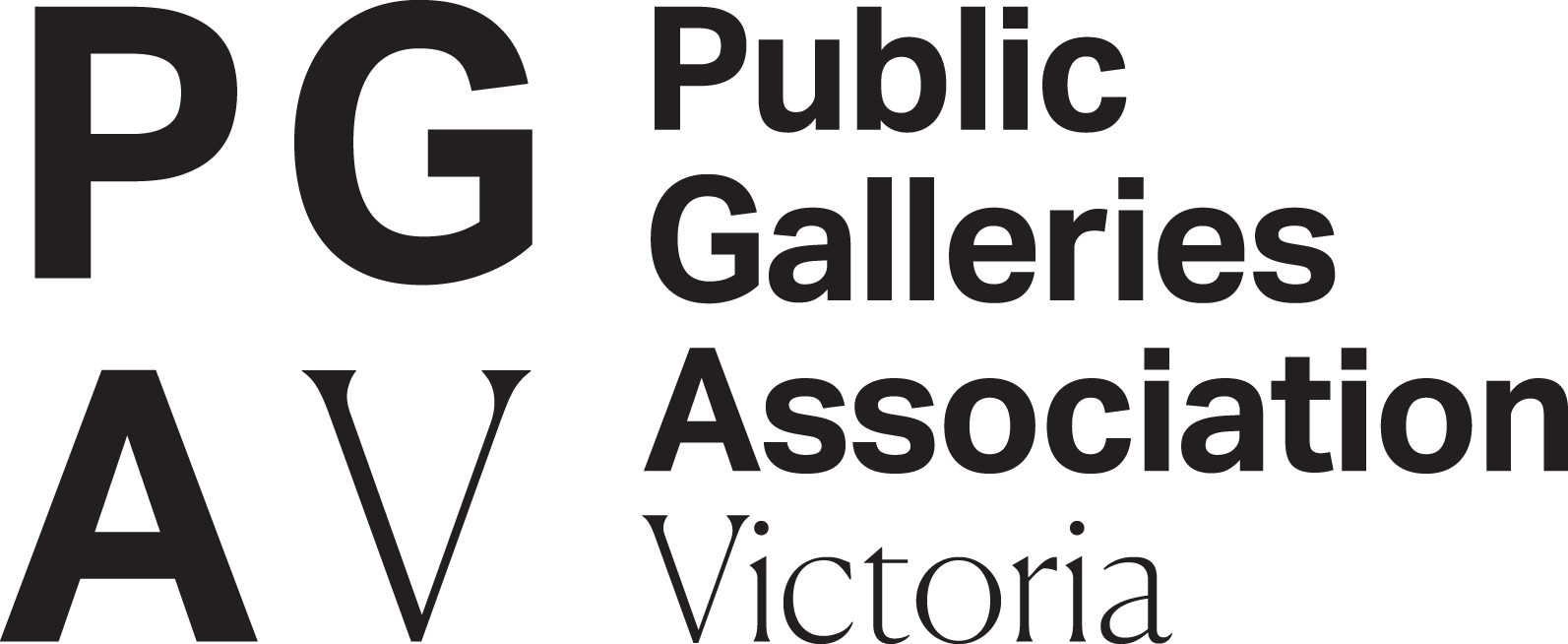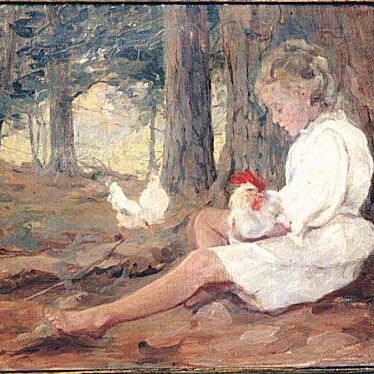
Clara Southern

Photograph in The Bulletin,
29 May 1929
State Library of South Australia.
This special series of online newsletters celebrate the outstanding contribution of members, past and present, artists and events.
At present, the newsletters are focusing on the important contribution made by the women artists of the Heidelberg School to our society.
This Newsletter features Clara Southern and her life with words provided by Art Historian Andrew Mackenzie OAM.
"Like fellow artist, Elizabeth Parsons, Clara Southern was a pioneer for women's equality in the Arts, and for the professional standing of women artists. She was one of the first women to be elected to the Buonarotti Society, this taking place on 23 January 1886. She was also the first woman member of the Australian Artists' Association, and the first woman to serve as a member of its committee.
From 1902 to 1906, Clara Southern was elected a member of the Council of the Victorian Artists Society, once again displaying her interest in protecting and enhancing the professional rights of women artists. She exhibited with the Victorian Artists Society from 1889 to 1917."
Clara Southern
Australia 1860-1940
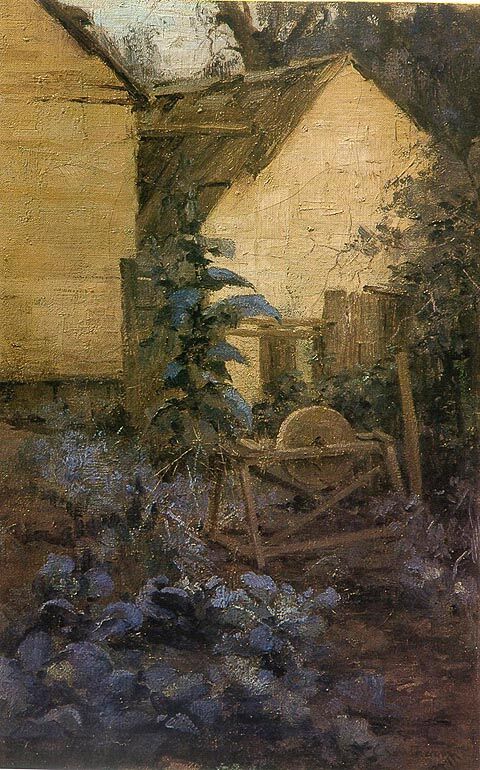
THE CABBAGE PATCH, c.1899
A peaceful plein air work in which the artist has captured the tranquil mood of the cabbage patch in the soft light of late afternoon. There is stillness in the air, with the only signs of habitation being the cottages in the background, and an old grinding wheel, which has not been recently in use, as around it, cabbages have begun to grow. This work was offered for sale through Sotheby's.
Fine Australian Paintings. November 1990, Catalogue no.231.
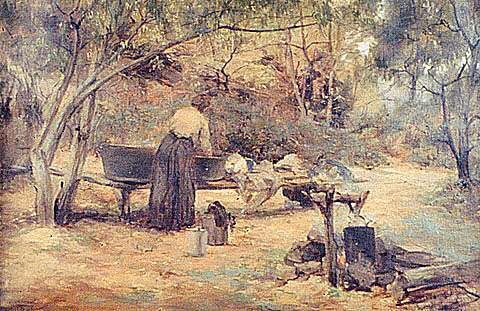
A COUNTRY WASHHOUSE, c. 1905
This is one of a number of plein-air paintings that Clara Southern produced where a woman is depicted at work within a domesticated bush landscape. Another of these paintings is ‘An Old Bee Farm, c. 1900’, and in both cases the model is painted in a similar pose, and in a range of colours which complement her surroundings and help her blend in as a natural part of the environment. When Clara Southern first moved to Warrandyte, the country washhouse was a common sight, with the hot water boiled in a large billy over an open fire, and copper tubs used for washing the clothes.
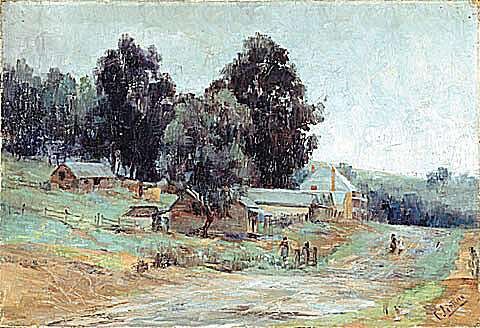
WARRANDYTE HOTEL, c. 1910
Clara Southern painted this work from close to where Webb Street and Main Street, now Yarra Street, Warrandyte intersect. Her view is from the north side of the street, looking towards the west. The substantial two-storey building on the rise in the distance is ‘The Grand’ Hotel, which was constructed in 1895-96 on the site of the old ‘Anderson’s Creek Hotel’. ‘The Grand’, was owned at this time, by Francis Trezise. ‘The Grand’ still stands today, although considerable modifications have been made to the original building.

AUDREY AND CHICKAPICK, 1911
Clara Southern painted this work in the Summer of 1911, in the garden of Professor Osborne’s property, ‘Lowestoft’, North Warrandyte. Situated at the end of Osborne Road, the house and garden, including the large pines in the background, were destroyed in a bushfire early in 1939. The work is one of considerable warmth, sensitivity and observation. It depicts Audrey, born 17th October 1905, and oldest of Professor Osborne’s four children, seated by one of the pine trees. In her lap she holds ‘Chickapick’, the family rooster, who looks to be resting comfortably, yet is also ever watchful.
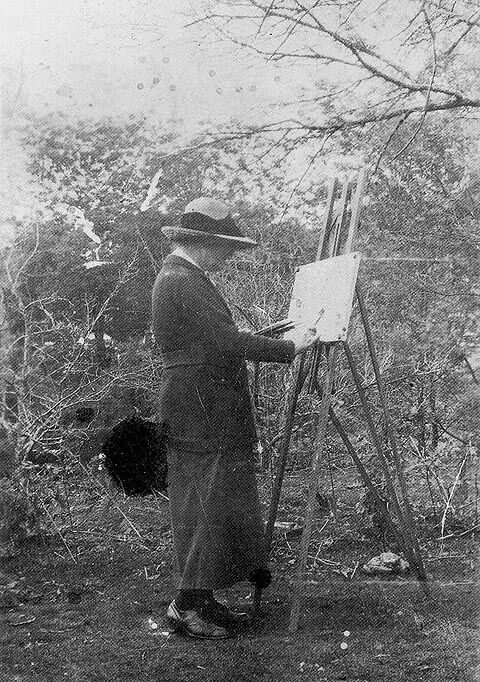
Photograph courtesy of artist's family

AN INSIGHT INTO CLARA SOUTHERN'S LIFE AND HER ART BY LEADING ART HISTORIAN ANDREW MACKENZIE OAM
"Clara Southern was born near Kyneton, Victoria on 3 October 1860, and was the eldest surviving child of five daughters and one son of John Southern, local timber merchant and farmer, and his wife, Jane, nee Elliott.
Her early art training commenced with lessons from Madame Blanche Mouchette, painter, schoolmistress and founder of the Alliance Francaise in Victoria, who conducted classes from her home 'Oberwyl' in Burnett Street, St. Kilda. Clara Southern also took lessons from Walter Withers, visiting him at his home in Heidelberg, and developing a lifelong friendship with the artist and his family.
Her artworks, especially of Warrandyte, show the strong influence of Withers' teaching, and Withers in his later years, while living in Eltham, would often call on Clara Southern at her home in North Warrandyte.
Between 1883 and 1885, she attended lessons in the School of Design, National Gallery of Victoria, under the Master of the School, Oswald Rose Campbell. In the second half of 1886 and in 1887, she again attended the National Gallery of Victoria, this time enrolled in the School of Painting, under George Frederick Folingsby.
Like fellow artist, Elizabeth Parsons, she was a pioneer for women's equality in the Arts, and for the professional standing of women artists. She was one of the first women to be elected to the Buonarotti Society, this taking place on 23 January 1886. She was also the first woman member of the Australian Artists' Association, and the first woman to serve as a member of its committee.
In 1888, Clara Southern sublet rooms from Tom Roberts in Grosvenor Chambers at 9 Collins Street, Melbourne, and over the next ten years, these rooms were used as her studio, which she shared with Jane Price and Jane Sutherland.
In the early 1890's, Clara Southern conducted drawing and painting classes in her studio, and regularly joined her male colleagues of the Heidelberg School on their plein air painting trips to Heidelberg and Eaglemont, where she painted plein air works such as 'The Cabbage Patch', c. 1899.
From 1902 to 1906, she was elected a member of the Council of the Victorian Artists' Society, once again displaying her interest in protecting and enhancing the professional rights of women artists. She exhibited with the Victorian Artists' Society from 1889 to 1917.
She joined the Lyceum Club, and became an active member of the Lyceum Club Art Circle. The Lyceum Club also boasted artist members such as Dora Wilson, Jessie Trail, A.M.E. Bale, Violet Teague and E.M. Sweatman who formed the Society of Twenty Melbourne Painters in 1918. Mrs Frederick (Annie) McCubbin and Mrs Arthur (Nora) Streeton were also active members of the Lyceum Club.
Clara Southern also became a member of the Melbourne Society of Women Painters and Sculptors, and the Twenty Melbourne Painters, with whom she exhibited regularly. Her works were exhibited in the
First Exhibition of Australian Women's Work, held in the Exhibition Buildings, Melbourne in 1907, and it has been suggested that at this time she was 'the most prominent female landscape artist in Melbourne'. She later held a major solo exhibition in the Athenaeum Gallery in 1914, and had works accepted for the Panama Pacific Exposition in 1915, such as 'Bush Camp' c. 1914.
On 9 November 1905, she married miner, John Arthur Flinn at St. John's Anglican Church, Blackburn, and the couple settled in North Warrandyte. Their cottage 'Blythe Bank' was situated on 'The Hill' above the Yarra River and overlooked the township of Warrandyte. A description of 'Blythe Bank' and the artist's impression of her home is provided on this site, with the work 'The Artist's Home', c.1909.
Clara Southern in her student days had been given the nickname 'Panther', and was described as a tall lithe beauty, with reddish fair hair. She was known to have a warm and generous nature, and was very much the catalyst behind Warrandyte becoming known for its artistic community. She made friends easily, and Professor Osborne's daughter, Audrey, recalled posing as the model on her parents North Warrandyte property, for 'Audrey and Chickapick', 1911, and later Clara Southern giving her the painting as a gift.
Clara Southern encouraged many young artists to visit her studio at Warrandyte, and several settled nearby and established studios of their own. Visitors to 'Blythe Bank' included Walter Withers and his family, members of the McCubbin and Colquhoun families, Penleigh Boyd, Charles Wheeler, Harold Herbert, Frank Crozier and 'Jo' Sweatman, who became her neighbour, living at 'Kipsy'.
Clara Southern's works captured the very spirit of Warrandyte. She captured the beauty of Warrandyte in her panoramic work 'Evensong', c. 1900-1914, and depicted local landmarks in works such as 'Warrandyte Hotel', c. 1910. She also captured the tranquility of the nearby Yarra River, in a work such as 'A Cool Corner', c. 1918. A number of her works depicted women at work within a domesticated bush landscape, and two fine examples of this are 'A Country Washhouse', c. 1905, and 'An Old Bee Farm', c. 1900. Like her close friend, Frederick McCubbin, she also captured women at work in the kitchen, and a fine example of this is 'The Kitchen', 1912.
Clara Southern became a well-known local identity in Warrandyte and found ready sales for her artworks among the wealthier residents of Warrandyte and Eltham. Unfortunately, these residents lived in areas of high bushfire risk, and many of her major works were lost in the bushfires that devastated these areas in 1939. She was very aware of the threat of bushfires, and the tragedy and hardship that they brought, and contributed to the Artists' Bushfire Relief Fund Exhibition. She was also aware of the plight of the Aborigines in Central Australia, and supported the efforts of fellow Lyceum Club member, Violet Teague and her half-sister, Una, in an exhibition they organized in aid of the Hermannsburg Mission Water Supply in Central Australia, after visiting this area in 1933.
Clara Southern remained in Warrandyte and was often visited by other local artists. She died at the age of eighty, on 15 December 1940, and was cremated. Sadly, 'Blythe Bank', which had survived the devastating 1939 bushfire, was destroyed by a later bushfire, which burnt much of 'The Hill' of North Warrandyte.
Media Enquiries:
Ron Smith OAM Hon FVAS, Victorian Artists Society - Mobile: 0417 329 201
Acknowledgment of traditional owners.
We would like to pay our respects to the traditional owners of the land on which our building stands, their leaders, past, present and emerging.

